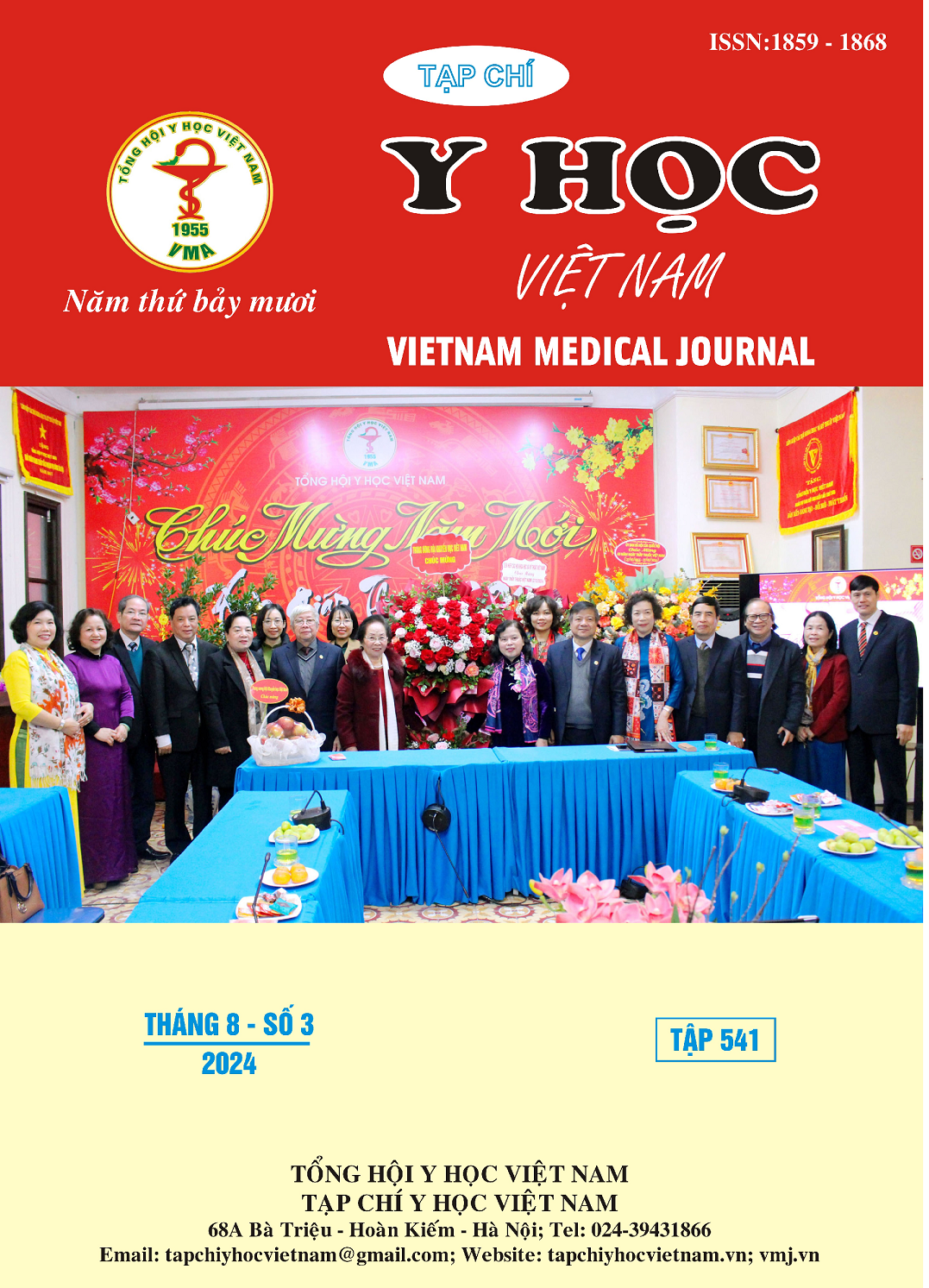TỶ LỆ LIỆT DÂY THẦN KINH THANH QUẢN QUẶT NGƯỢC SAU MỔ CẮT THỰC QUẢN, NẠO VÉT HẠCH 3 VÙNG ĐIỀU TRỊ UNG THƯ BIỂU MÔ VẢY THỰC QUẢN TẠI BỆNH VIỆN ĐẠI HỌC Y HÀ NỘI
Nội dung chính của bài viết
Tóm tắt
Mục tiêu nghiên cứu: Mô tả đặc điểm lâm sàng, cận lâm sàng và tỷ lệ liệt dây thần kinh thanh quản quặt ngược (TKTQQN) sau mổ ở người bệnh được phẫu thuật nội soi ngực bụng cắt thực quản, nạo vét hạch 3 vùng điều trị ung thư biểu mô thực quản tại bệnh viện Đại học Y Hà Nội. Phương pháp nghiên cứu: Nghiên cứu mô tả tiến cứu trên 20 người bệnh ung thư biểu mô vảy thực quản được phẫu thuật nội soi ngực bụng, nạo vét hạch 3 vùng. Kết quả và bàn luận: Tuổi trung bình 59.75 ± 6.96. Nam giới chiếm tỷ lệ 100%. Vị trí u: 1/3 giữa chiếm 56.2%, 1/3 dưới chiếm 48.2%. Giai đoạn IIB và IIIB chiếm tỷ lệ nhiều nhất 31.5%, giai đoạn IA, IB, IIA đều chiếm 12.5%. Tỷ lệ liệt dây TKTQQN có 7 trường hợp chiếm tỷ lệ 35%. Trong đó tỷ lệ hồi phục hoàn toàn 1 tháng sau mổ có 4 trường hợp chiếm 57,1%, tỷ lệ liệt không hoàn toàn có 1 trường hợp chiếm 14,3% và tỷ lệ liệt hoàn toàn sau mổ có 2 trường hợp chiếm 28,6%. Kết luận: Tỷ lệ liệt dây TKTQQN trong nghiên cứu của chúng tôi khá cao chiếm 35%. Trong đó tỉ lệ liệt hoàn toàn sau mổ 1 tháng là 28,6%, còn lại 71% là liệt không hoàn toàn và hồi phục hoàn toàn sau mổ.
Chi tiết bài viết
Từ khóa
: Ung thư thực, nạo vét hạch 3 vùng, tỷ lệ liệt dây thần kinh thanh quản quặt ngược.
Tài liệu tham khảo
2. Booka E, Takeuchi H, Nishi T, et al. The Impact of Postoperative Complications on Survivals After Esophagectomy for Esophageal Cancer. Medicine (Baltimore). 2015;94(33):e1369. doi:10.1097/MD.0000000000001369
3. Berger AC, Farma J, Scott WJ, et al. Complete response to neoadjuvant chemoradiotherapy in esophageal carcinoma is associated with significantly improved survival. J Clin Oncol Off J Am Soc Clin Oncol. 2005;23(19):4330-4337. doi:10.1200/JCO.2005.05.017
4. Li B, Hu H, Zhang Y, et al. Three-field versus two-field lymphadenectomy in transthoracic oesophagectomy for oesophageal squamous cell carcinoma: short-term outcomes of a randomized clinical trial. Br J Surg. 2020;107(6):647-654. doi:10.1002/bjs.11497
5. Lerut T, Nafteux P, Moons J, et al. Three-field lymphadenectomy for carcinoma of the esophagus and gastroesophageal junction in 174 R0 resections: impact on staging, disease-free survival, and outcome: a plea for adaptation of TNM classification in upper-half esophageal carcinoma. Ann Surg. 2004;240(6):962-972; discussion 972-974. doi: 10.1097/01.sla. 0000145925.70409.d7
6. Murakami M, Otsuka K, Goto S, Ariyoshi T, Yamashita T, Aoki T. Thoracoscopic and hand assisted laparoscopic esophagectomy with radical lymph node dissection for esophageal squamous cell carcinoma in the left lateral decubitus position: a single center retrospective analysis of 654 patients. BMC Cancer. 2017;17(1):748. doi:10.1186/s12885-017-3743-1
7. Otsuka K, Murakami M, Goto S, et al. Minimally invasive esophagectomy and radical lymph node dissection without recurrent laryngeal nerve paralysis. Surg Endosc. 2020;34(6):2749-2757. doi:10.1007/s00464-020-07372-3
8. Scholtemeijer MG, Seesing MFJ, Brenkman HJF, Janssen LM, van Hillegersberg R, Ruurda JP. Recurrent laryngeal nerve injury after esophagectomy for esophageal cancer: incidence, management, and impact on short- and long-term outcomes. J Thorac Dis. 2017; 9 (Suppl 8): S868-S878. doi:10.21037/ jtd.2017.06.92
9. Taniyama Y, Miyata G, Kamei T, et al. Complications following recurrent laryngeal nerve lymph node dissection in oesophageal cancer surgery. Interact Cardiovasc Thorac Surg. 2015;20(1):41-46. doi:10.1093/icvts/ivu336


